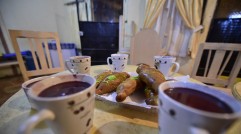New Way to "Herd" Cells is a Medical Breakthrough
Researchers at the University of California, Berkeley have discovered a way to move groups of cells together with an electrical current, a potential breakthrough in healing technology.
Described this week in the journal Nature Materials, the study focused on single layers of epithelial cells, the kinds of cells that bind together to form strong coverings for the skin, kidneys, cornea, and other organs.
The research team found that, by applying an electric current of about five volts for each centimeter, they could encourage basically herd cells along the direct current electric field.
The scientists were able to make the grouping of cells shift left as well as right altogether, to separate from each other and them converge and even effect collective U-turns.
It was also found the excited cells could be molded into rather elaborate shapes, such as that of a triceratops or the university's California bear mascot.
"This is the first data showing that direct current fields can be used to deliberately guide migration of a sheet of epithelial cells," study lead author Daniel Cohen, who conducted the work as a student in the UC Berkeley-UC San Francisco Joint Graduate Program in Bioengineering, said in a news release.
"There are many natural systems whose properties and behaviors arise from interactions across large numbers of individual parts -- sand dunes, flocks of birds, schools of fish, and even the cells in our tissues," he said. "Just as a few sheepdogs exert enormous control over the herding behavior of sheep, we might be able to similarly herd biological cells for tissue engineering."
Thanks to the success of their recent experiment, the UC researchers can now envision a time in the not-too-distant future when an electrical current could be used to direct the flow of a group of cells for potential medical applications, such as "smart bandages," that use electrical stimulation to help heal wounds, and even certain levels of tissue engineering.
"The ability to govern the movement of a mass of cells has great utility as a scientific tool in tissue engineering," said study senior author Michel Maharbiz, a UC Berkeley associate professor of electrical engineering and computer sciences. "Instead of manipulating one cell at a time, we could develop a few simple design rules that would provide a global cue to control a collection of cells."
)
Subscribe to Latin Post!
Sign up for our free newsletter for the Latest coverage!













